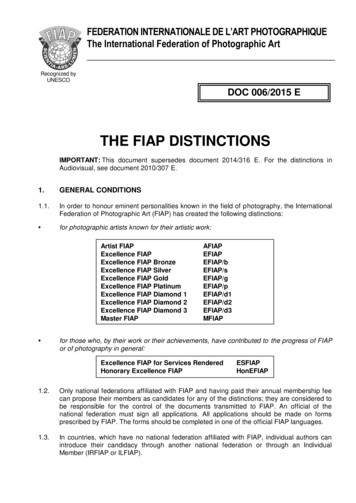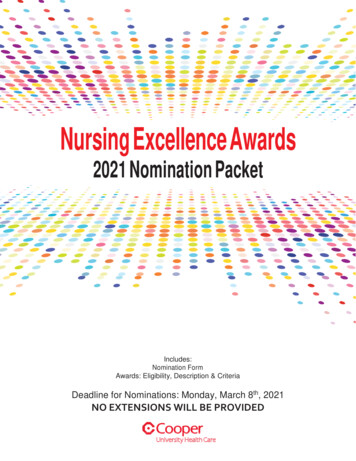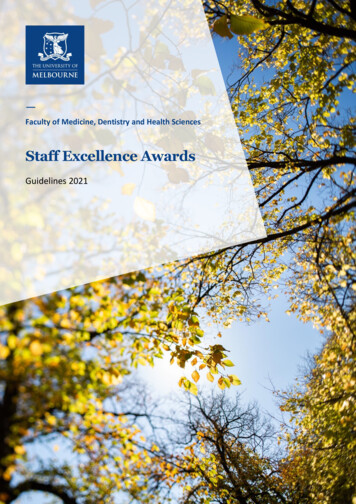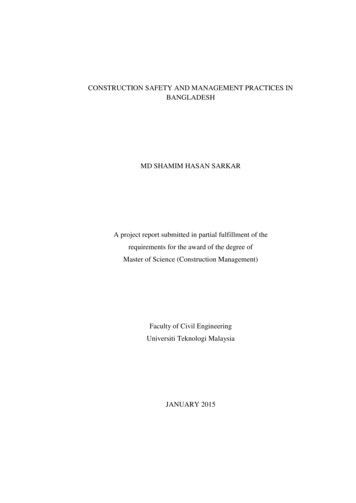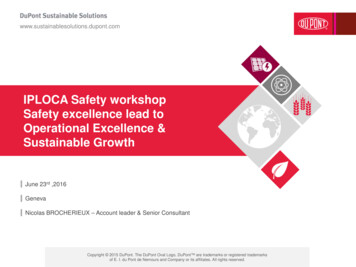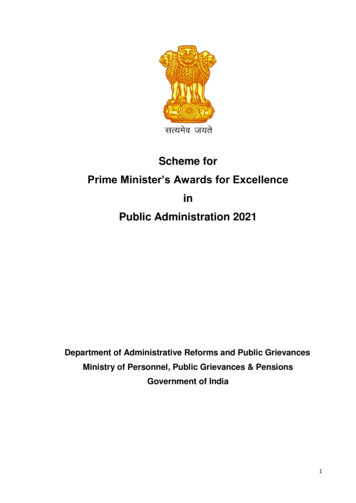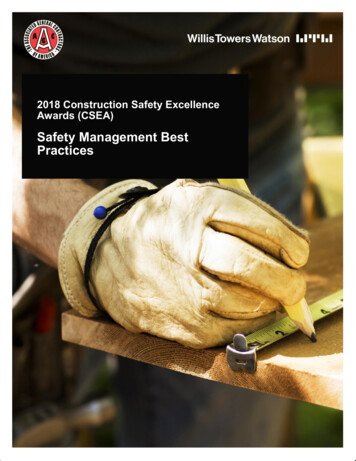
Transcription
2018 Construction Safety ExcellenceAwards (CSEA)Safety Management BestPractices
IntroductionOn February 27, 2018, the AGC-Willis Towers Watson Construction Safety Excellence Awards (CSEA) breakfastwas held at the AGC National Convention in New Orleans, Louisiana. Almost 1,000 contractors attended.The AGC-Willis Towers Watson CSEA program is the industry’s elite safety excellence awards program forcompanies of all sizes and occupational divisions. It is unique because finalist contractors make five-minutepresentations to five judges. The judges then ask each finalist a series of unknown questions for 10 minutes. TheCSEA program recognizes companies that have developed and delivered premier safety and risk control strategies.Additionally, CSEA showcases companies that have achieved continuous improvements and maintenance of theirsafety and health management systems. In 2018, there were 59 total finalists among 7 divisions and 21 categories.AGC–Willis Towers Watsonpresented the Grand Award forConstruction Safety Excellence toRosendin Electric, Inc. The firstplace winner of each categorywas included in the evaluationthat determined the “Best of theBest” of the 2018 ConstructionSafety Excellence Awardsfinalists.CSEA – 2018 Safety Management Best Practices1
Profile of the Grand Award WinnerCompany BackgroundRosendin Electric, Inc., headquartered in San Jose, Calif., is an employee-owned electrical contractor. Withrevenues surpassing 2 billion, Rosendin is one of the largest electrical contractors in the United States employingover 6,000 people. For nearly 100 years, Rosendin has created a reputation for building quality electrical andcommunications installations, building value for clients, and building people within the company.Rosendin’s quest to be the AGC-Willis Towers Watson CSEA Best of the Best:Rosendin’s implemented policies and training have helped diminish job site hazards and involve employees andsubcontract employees in every aspect of safety. On their first day, each employee is given a Stop Work Card.This card empowers all Rosendin employees to judge any work situation and “Stop Work” at any time if they feelunsafe. A “5Why” Accident Investigation Form was created with a focus on discovering the root cause of anaccident and the “Whys” behind each step that occurred. A Pre-Task Plan (PTP) policy was implemented to helpemployees stay focused, organized, and to recognize hazards before work commences and throughout their day.Digital Pre Task Plans were developed for iPads with links to allow for remote access of permits. To ensure propertool use, Tool Training Posters were designed with QR codes, accessible on any smart device, that providetraining and proper use videos for every utilized tool. During Energization and Testing programs, Methods ofProcedures (MOPS), Step-by-Step (SBS), and QA/QC were put into place to allow for time validation and ensurethe correct precautions are taken. Real-Time Auditing controls and keeps track of hazards to identify and maintainsafe work environments that are reviewed by Rosendin’s safety team and field supervisors.Rosendin, together with other electrical contractors, is part of the NECA Large Contractor Group that is workingtowards ways to create safer working environments and improve safety throughout the industry. In addition,Rosendin is making an impact through collaborations with large tool manufacturers to create new and safer toolprototypes for future use industry wide.What we have learned and changed in our organization over the years by entering thecompetitionOver the years, we have continued to take a deeper look at the quality of projects that we work on, not just thequantity. We ensure that regardless of where Rosendin employees work, the project team holds safety and securityin the highest regards. In addition, Rosendin has introduced new and innovative technologies to the constructionindustry to reduce risk and injuries on the jobsite.Why Rosendin approaches safety in the way that we do?We have a passion for safety. A passion for ensuring that our people go home safe each day; for building projectsthat enhance the lives of people in our communities; and for building a greater tomorrow.At Rosendin, we are striving to build a better America and evolve construction and the industries that we are in.Safety is a catalyst in making this happen. Safety at Rosendin begins with giving each of our employees a voicethat we listen to and that provides each person ownership in our successes.CSEA – 2018 Safety Management Best Practices2
Message to companies who have not entered beforeSafety is not proprietary; it is something that everyone in the industry holds in high regards. We want to motivateother companies to bring something new to the table; something that we have not seen before, and that can beimplemented to create a safer tomorrow. By entering this competition, everyone has the opportunity to learn fromeach other on how to improve their safety program. The judges’ feedback is very important because it providesinformation and suggestions on how a company can improve their safety program.How we plan to use our recognition as a competitive advantageBeing the 2018 Construction Safety Excellence Award recipient gives Rosendin Electric a competitive advantage inour recruitment efforts. When looking for new talent, we emphasize the policies and procedures that Rosendin hasin place to create one of the safest working environments in the nation. We advertise our award wherever andwhenever we can. This includes placing the CSEA Grand Award Winner image on all outgoing employee emailsignatures, on the Rosendin website and intranet, and on t-shirts. Hard hat stickers with the CSEA award werehanded out to all employees, project site/office banners and posters were created, and celebrations were held inoffices company-wide to thank our employees for working safe. Being the 2018 CSEA Grand Award Winner wouldnot have been possible without the commitment to safety from everyone within Rosendin.2018 CSEA JudgesThe AGC-Willis Towers Watson finalist judges were (L-R)Mike FredebeilJane BeaudryBill ParsonsTreasa TurnbeaughTony MilitelloOn January 8-9, 2018 in Long Beach, California prior to the AGC National Safety Committee meeting, preliminaryjudging for the CSEA final competition took place. A total of 31 preliminary judges consisting of safety professionalsfrom the construction industry, AGC Chapters, construction brokers, and construction insurance carriers evaluatedand scored the initial 101 CSEA applications from across the country.CSEA – 2018 Safety Management Best Practices3
2018 CSEA Safety Management Best Practices33% of CSEA Finalists have supervisorsthat completed OSHA 30-hour forConstruction60% of CSEA Finalists providesupervisors with an additional 10hours of Safety Orientation Training38666% of CSEA Finalists useemployee safety perceptionsurveys.Safety Management Best Practicesto share with the Construction Industry60% of the surveys were developedin-house. 40% were administered by a 3rd party.CSEA Finalists provided an averageof 3.5 hours of New Employee SafetyOrientationCSEA 2108101 Applications59 FinalistsThe above Word Cloud represents the most used words in all the finalists’ applications.The size of the word represents how often it was used.CSEA – 2018 Safety Management Best Practices4
2018 CSEA Safety Management Best PracticesThe following combines many noteworthy Safety Management Program elements highlighted bypresenters and noted by the judges during the final competitionSenior Management Ownership and Participation Safety is the first message received when a worker arrives on site. Safety is the first agenda item for every jobmeeting. Safety starts at the top: our COO is our Safety Officer andis involved in all aspects of operations. President and VP demonstrate ownership and participationby their commitment to the same level of safety trainingthey require of the project management teams. Safety is not an incentive, it is a culture. Owners are retrained on OSHA 30 every two years andattend CPR/1st aid training. Annually, Project Managers and Superintendents haveperformance evaluations based on safety managementparticipation and performance. Implemented a communications tool using mobiletechnology that requires Foreman to be in daily contact with the Safety Department, thus ensuring supervisorsare engaged and accountable for safety performance on every project, every day. The tool also allows theSafety Director to “broadcast” critical messages (such as Heat Illness alerts) quickly and efficiently to the field. Hired three additional Safety Supervisors lowering employee to Safety Supervisor ratio. Owners send out personal video safety messages when concerns have arisen. They are shown on every jobsite, to all employees, as a personalized safety alert or safety stand down. They are also shared on socialmedia so other contractors may benefit as well. Safety Crew Lunch where Owners, site management and the safety team lead a lunch meeting thatencourages involvement from the employees. They review the project's safety procedures and the status of theproject. The “Ownership Thinking” process teaches employees to think like an Owner, where ideas and thoughts canbe expressed to make a better, safer and healthier company. Since the inception of “Ownership Thinking”, over17 new ideas or programs have been initiated by our employees. Monthly joint project visits by President/Owner and the safety director to perform safety audits. Gives thePresident an opportunity to visit with the team to find out what they need to make them and their projects safer. The safety department budget is 1.9 MM dollars. This includes labor, materials, training and equipment, aswell as subcontracted costs for specialty items related to industrial hygiene monitoring. "Readiness Review" is a process where the project team must review their safety plan with the Owner, whosigns off on the plan after detailed questioning. Owners communicate weekly to all projects via Go-To Meeting. The Safety Manager shares information fromthe week posted in "Basecamp," a collaborative and innovative application that makes information sharing andteam work easier than ever before. This technology allows all remote project locations to be able to see andhear the same information as our main office. Use of the Basecamp application (https://basecamp.com)provides all Superintendents and Project Managers up-to-date safety information directly to their phone orproject iPad.CSEA – 2018 Safety Management Best Practices5
Safety statistics may meet the criteria of a compliance based organization, but we operate as a learningorganization, always striving to improve. "LIFE CRITICAL RULES" and our employee handbook document and support that violation of these rules aregrounds for termination. Applies to following hazards: Falls, Electrical, Lockout-Tagout, Confined Space, and15' safe zone around equipment. Every new employee learns in orientation about the“three-second decision” from senior executives. For theexecutive, it’s personal, as he lost his own father when hewas quite young, because his father did not make thethree-second decision that could have saved his life. Thisconversation at orientation is the beginning of theleadership safety commitment to every employee. Turned our “compliance” based safety program into aninnovative safety “performance” culture. Every Monday, Project Managers and Superintendentsshare safety information with all crews. They are trackedfor participation. Executive leaders and senior managers attended a 2-day safety commitment workshop. Coaching sessionsfollow. Ten (10) operational leaders are picked to lead a 4-hour “incident and injury free” orientation for all 550employees and temporary workers. Every Friday, Senior Management conducts a mandatory company-wide webcast, where teams from eightoffices discuss topics that range from daily reminders to near misses with potentially deadly consequences. All safety professionals and managers are included in all management meetings. Have a national and areaoffice safety committee comprised of both safety and operations personnel. Safety and Health Management System conforms toOHSAS 18001https://en.wikipedia.org/wiki/OHSAS 18001 Core Safety Participation Report measures our efforts. Werecord attendance for each safety meeting or inspection andtrack participation for field supervisors and management,against set criteria, consistently achieving over 85%participation across the company. Stopped talking about "lack of accidents" and have begunfocusing on "what we do to keep them from happening." Anonymous complaint hotline. Information goes directly toour CEO and an outside board member. This allows the stewards of our brand to receive and handle issuesthat may arise with site or middle management, making sure that issues are settled in an appropriate andsustainable way. CEO mandated all field employees receive an OSHA 10-hour and all supervision receive an OSHA 30-hourcourse. Spent 14 weekends training approximately 600 workers. More than 7,500 work hours were spent in justOSHA training in 2017. Each division is charged their percentage of total company Workers Compensation premium and is given 100%of what is not spent directly on injuries back to their bottom line, thereby, increasing their bonuses. SAFETY is not a responsibility. It is an avenue to invent, invest, inspire, create and receive the attention thatsomeone cares. Created a large electrical contractors network group that is focused on sharing the best known methods ofsafety across the world, shaping and enhancing each other’s safety programs. All new hires are required to view a professionally produced safety commitment video from the President.CSEA – 2018 Safety Management Best Practices6
Senior VP shares his personal experience with an arc flash accident earlier in his career, where he wasseverely burned. Executives, Regional Managers, and the safety staff come together quarterly to discuss corporate safetyperformance and share lessons learned and “Best Known Methods”. Leaders are required to share a "My Safety Feedback & Improvement Plan" with all employees each year. Every leader (from Executive to Foreman) participates in a “My Safety” Leadership Workshop, with goalsfocused on: effectively applying safety leadership qualities/processes, empowering employees to takeresponsibility for their safety, recognizing and correcting hazards, conducting meaningful safety talks andplanning meetings, making projects safer by always doing what’s right, and having personal plan for action thatintegrates safety values into all they do. Key leadership topics include: Chronic Unease, Error Traps, Drift and Attitude Charting. Over 20 workshopshave been conducted, with more than 150 leaders participating. The President, Vice Presidents, Project Managers and Superintendents participate in Safety Challenge processwhile visiting jobsites. If a member of Management observes a team member performing in full compliance,they ask the team member a question from the Field Safety Hand Book. The Challenge is designed to getmanagement and team members talking about safety in a positive, non-intimidating way. If the question isanswered correctly, the team member receives a 5.00 gift card and their name appears as a winner in thenewsletter. To facilitate good task planning and a safe work start, no meetings can be scheduled before 8 a.m. Six craft workers have lunch with the President, no foremen present each month. Exchange ideas and issues. Two-hour leadership training for all employees, craft to leadership. Theme is not about safety on the job, butrather safety in our lives. Good Safety is Good Business Separate performance evaluations. Foremen with no OSHA Focus 4 at-risk observations receive recognition,gift card, and salary bonus. President attends and participates in every new hire orientation to demonstrate safety commitment. If there is a sensed lack of team engagement, a "Rapid Response" team mobilizes to project site to addressteam concerns. Owners not only support a Drug Free Workplace, but require random testing – they also personally take part inthe random testing. Company streamlined its safety newsletter and updated the contents. Communicate monthly safety matrix,goals and highlight projects. Ensure Project Managers write the safety articles, not safety coordinators. President attends safety meetings unannounced. He participates in jobsite safety walks and communicates withthe subs too. Demonstrated management participation by being seen walking the jobsites and doing JHA auditsRisk Identification and Analysis Require all personnel to conduct a safety observation report on Predictive Solutions SafetyNet software.Predictive Solutions SafetyNet helps collect safety data on projects. The results include positive safetyawareness as well as any safety issues and non-issues that can be present on a jobsite. The data is thenanalyzed and all observations are communicated with the subcontractors during their meetings. Monthly specific safety plan for each project. Monthly Superintendent conference to share safety lessons learned and safety initiatives. Use an online motoring service to track Motor Vehicle Records for those who drive a company truck or theirtruck on company business (Negligent Entrustment prevention).CSEA – 2018 Safety Management Best Practices7
Predictive Solutions SafetyNet is used to document behaviors and conditions. These observations, inconjunction with historical event data, are used to predict where challenges and where the next event may arisein the future. Incidents including “Near Miss” events arethoroughly investigated with a root cause analysisand a formal report, followed by a presentation tothe management team and a Lessons Learneddocument. Site specific fire prevention plan is covered duringorientation and audited throughout project duration. Anyone who drives on company business isrequired to attend driver training, which includesDefensive Driving. All employees driving records arereviewed before they are allowed to drive. Every week the jobsite Foreman writes a formal document in regards to safety and health. The frequency isrequired due to ongoing changes in the work environment and equipment. All drivers who drive on company business receive a six hour defensive driving course (NSC). Driver MVRs arealso checked every six months. Safety Stratus safety software utilized to document safety observations- https://www.safetystratus.com Every 30 days, a loss history analysis is prepared for our projects and is reviewed at Safety Meetings. Two-week look-ahead schedule is posted at jobsite trailers to forecast what is coming up to trigger plans foraddressing safety issues. Supervisory safety behavior observation program and their participation is a critical part of the performanceevaluation. These observations are reviewed during the employees review and are heavily considered forpromotion. Each position has a job description and is reviewed closely with physiciansduring physicals, range of motion exams and fitness for duty exams. Prior to project beginning an intensive risk analysis is completed and isevaluated and adjusted through the life cycle of the project. Sequentially, prebid plan reviews are completed utilizing “Virtual Construction” technologies. Projects use a proprietary mobile app to document safety. The appdocuments both positive and unsafe behaviors in real time. Images andreinforcement are sent directly to subcontractor foremen and their teams. In2017, more than 600,000 observations were made using this system. Project estimators meet with safety personnel/project team during the pre-bidand pre-construction planning phase to budget people, project controls andPPE. All company employees that operate a company-owned vehicle or personaluse vehicle on company business is required to complete four-hourDefensive Driving and trailer towing (if applicable) training courses annually. Smartphone app allows employees to report safety observations from their mobile device. This safety data istrended across the business. With the trended data specific inspections, communications, and training aretailored to help focus efforts and drive specific injury numbers down that are currently occurring in the field. Forexample, shoulder strains and tears are down by 33%, and strains and strains overall are down by 40% thisyear through this process. Refined incident review process by categorizing contributing factors to get better and more consistentinformation. Also, built a tracking system that allows for the analyzation of common causes for incidents andlosses. Our definition of safety effectiveness extends to participation, hazard recognition, and training interest.CSEA – 2018 Safety Management Best Practices8
Lagging metrics are a result of “What” we did, and what can easily be attributed to luck. Measure crew participation with perception surveys conducted weekly by the safety department. The surveyquestions include such questions as, “when was the last time your boss spoke to you about safety and whatwas the last training class you went to”? Crewmember perceptions are trended and shared with supervisionand management on a quarterly basis. Employees’ engagement is measured in weekly affirmations. These include the acknowledgement thatcompany maintains an anonymous hotline to report employee complaints, and also include whether safetymeetings are being conducted properly, whether pay is being handled properly, and whether breaks are beinggiven. Developed an in-house app, "Safety Mojo," to track all safety communications from the field to the office andfrom the office to the field. Incident reporting, hazard identification, inspections and meetings are allcommunicated electronically and trended. Projects awarded that are over 250,000 require storyboards with all GC and subcontractor personnel, alongwith a safety representative tasked with identifying risk throughout project completion. High-risk tasks require awritten Job Hazard Analysis (JHA) identifying all potential hazards and mitigation plans. BIM 360 computer-based auditing program collects safety data from all job sites. The safety hazards andcorrective actions identified on projects are entered into the program for analysis. The data can then be trendedin an attempt to proactively identify areas of concern before an injury or incident. Overexertion injuries are difficult to control and often end up being identified during the first aid process. Wehave become very vigilant with regards to follow up treatment. Overexertion injuries (1st aid/Med only/Losttime) are monitored very closely throughout the healing process. This is extremely important with a soft tissueinjury, because very minor incidents can elevate in medical/treatment status very quickly, if not managed well. Use eCompliance program to audit, capture and communicate experiences containing elaboration anddiscussion of near misses and reports and investigations by the safety committee.https://www.ecompliance.com Safety observation documentation uses an in-house developed app called “Improve It,” that helps with reportingand capturing data for analysis. The data is presented in a series of models that allow for the drawing ofconclusions about future risk and take the necessary precautions to avert it. Root Cause Analysis (RCA) using Sologic Software is required for any OSHA recordable injury and oftware "What’s wrong with this picture" monthly safety quiz competition. "Craft Ride Along" program randomly selects a craft worker to conduct a safe ride along with one of the safetymanagers. An accident review committee is in place for the root cause analysis of all vehicular incidents. We have a dedicated QC manager, and all sites must comply with our ISO QC criteria. IndustrySafe is used for OSHA recordkeeping. It allows for maintenance of accurate recordkeeping at all times,for all projects. Any incident must be entered into the system within 24 hours. https://www.industrysafe.com Use multi-tiered inspection process. Weekly by supervisors, safety personnel and engineers. Monthly forProject Managers and Superintendents. Periodic inspections are conducted by Superintendents from othersites (cross walks). “Safety 5 Blocks” (project safety performance flash reports) are shared with ownership and leaders on aquarterly basis during Executive Project Reviews. “Safety 5 Blocks” are an integral part of this review andprovide a detailed look at leading & lagging indicators (safe & at-risk behaviors, safety training, safety audits,AHA schedules, injury rates and insurance savings). Annual Cross Business Safety Audit (CBA) – A detailed third party safety compliance assessment is conductedat client site to identify strengths and weaknesses of project safety efforts. CBA findings and corrective actionsare shared with ownership and leaders.CSEA – 2018 Safety Management Best Practices9
Safety Snapshot (BBS) is a tool used to engage employees/subcontractors by recognizing safe behavior whilepointing out those needing improvement. Snapshots encourage discussion of safe and at-risk behaviors, andhelp identify trends and whether additional safety training may be needed. Weekly Snapshots assistsupervisors in recognizing and managing safe and at-risk employee/ subcontractor behavior, while safetyaudits verify processes are in place and work conditions are safe. Vice Presidents and Project Managers conduct iAuditor audits each time they visit a job site. Superintendentsand Foreman also conduct audits weekly. The audits enable leadership to gather data from observations thatare used in a matrix to calculate risk and probability. When this data is calculated it is presented tomanagement weekly. https://safetyculture.com In the past the company experienced safety issues that could have been prevented if data collected providedaccess to project performance. Nothing was available commercially to do this. So the company developed anin-house program called “Acme Construction Analytics” which quantitatively measures the effectiveness ofcurrent processes and allows the prediction of future outcomes based on the data collected from pastperformance. Use Hazard Scout a cloud-based mobile friendly safety management system designed to foresee and controlhazards associated with safety and performance. https://www.hazardscout.com Use the DISC behavior assessment tool, a personality assessment tool thatfocuses on four different behavioral traits: dominance, inducement, submission,and compliance. This has allowed leadership to understand what type of approachneeds to be taken when dealing with one another based on personality. Developed additional support metrics through the use of "cost per hour" forjobsites, divisions, locations, Superintendents, PMs and foremen. Fatigue monitoring and fatigue messaging to home and family. Complete full Root Cause Analysis on all Near Misses. Implemented SafetyReports to track jobsite safety inspections, usingcomprehensive analytics to predict potential safety hazards. http://www.safetyreports.com It all starts with preconstruction - checklists created before project starts – hazards identified before projectstarts - either figure out ways to make the job safer during the design process or find ways to engineer in safepractices after the project starts.Task Design – Engineering Controls & Design for Safety Engineering controls to address safety concerns presented by the steep roof.Developed site-specific crane procedures to separate pedestrian and vehiculartraffic, which governed crane placement, truss storage and operation hours.The design minimized boom rotation into sensitive areas and avoided peakfacility hours for hoisting operations. Fall protection systems were adapted toaccommodate body harness connections within the complex truss system.Two specific fall arrest systems were used: continuous engineered static cablethat allowed carpenters to fasten to and move freely along the cable; andretractable fall limiting devices that are anchored incrementally and protectcarpenters maneuvering on sloped trusses. During construction of the six story tilt-up Client project, installed safety cablesin the window openings of all panels prior to erection. This building is one ofonly four, six-story tilt wall buildings in Texas. The building’s walls arecomposed of a lower four-story panel measuring sixty feet tall, with a two-storypanel measuring 35 feet in height stacked on top. Daily Huddles on projects are conducted to identify hazards and we then apply“The Hierarchy of Controls” in order to mitigate the hazard down to the lowestpossible risk level.CSEA – 2018 Safety Management Best Practices10
Contract to furnish and install nearly 700 linear feet of Operable Partitions. The 170 panels were each 22 feethigh by 4 feet wide, weighing over 1000 lbs. each. Crew designed and fabricated unique tooling to dramaticallysimplify the panel handling and raising operation. The safety tooling required half of the manpower previouslyrequired. The tooling also eliminated strenuous and potentially dangerous manual lifting. Designed fall protection system of stanchions and temporary horizontal lifelines continually advancing withmultiple leading edges. The metal decking scope was complicated by the numerous sloped triangular sectionsforming the roof canopy. Had to drill large deep shafts under high voltage lines where the drill rig would be in close proximity to the lines.Devised a plan to have the lines taken out of service and an electrical contractor was contracted to hold thelines away from the drill rig, so as not to come in contact with the lines causing any damage when they were reenergized. C
The AGC-Willis Towers Watson CSEA program is the industry's elite safety excellence awards program for companies of all sizes and occupational divisions. It is unique because finalist contractors make five-minute . Every Friday, Senior Management conducts a mandatory company-wide webcast, where teams from eight
